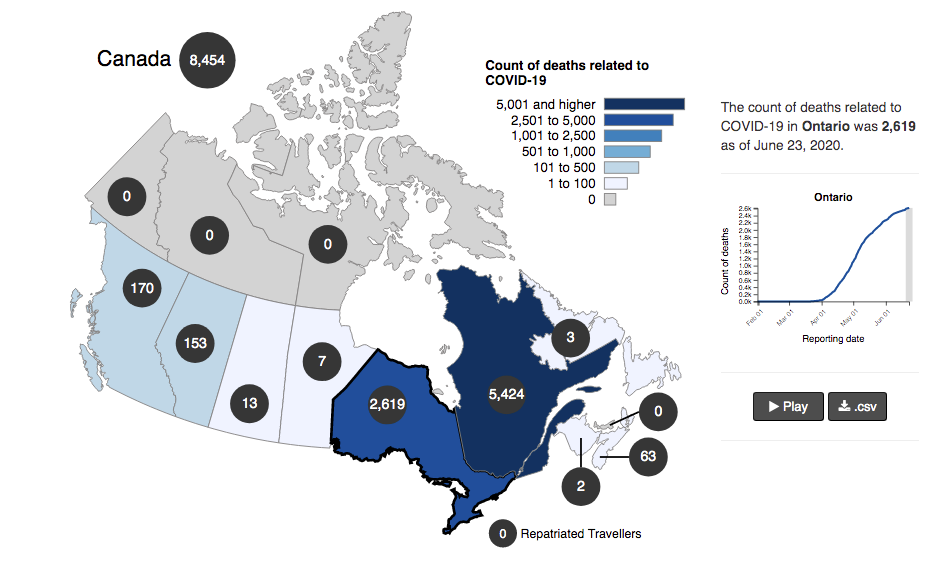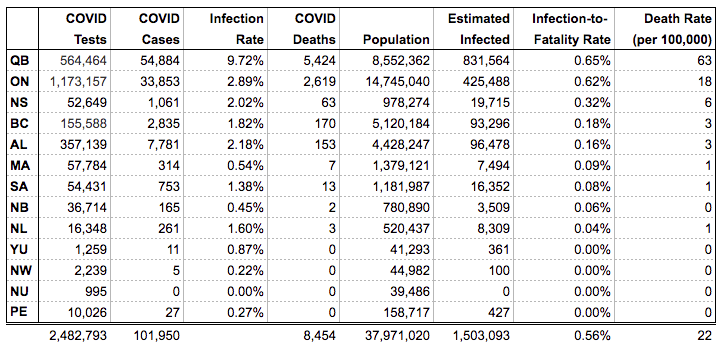Before Canadians surrender any more of their freedoms to COVID-19 propaganda, can we stop and ask some critical questions?
John C. A. Manley

“COVID is unquestionably much worse than a bad flu season,” says Dr. Allison McGeer, an infectious disease specialist at Toronto’s Mount Sinai Hospital, in an interview with the CBC.
McGeer cites government statistics (as of June 17) showing a COVID mortality rate of 22 deaths per 100,000 Canadians. “By comparison, the death rate for influenza in Canada on an annual basis is usually between nine and 13 deaths per 100,000 people…”
Does this one statistic really make COVID “unquestionably” worse than the flu?
Are not questions a fundamental part of the scientific process, whereby a theory is tested over the fires of inquiry?
Is not the act of questioning at the heart of true journalism?
Would you not agree that our ability to question the decisions, motives and actions of our government protects our democracy from descending into tyranny?

I‘m sorry Dr. McGeer, but I do have a few critical questions. Especially considering what is at risk.
Sir Wilfrid Laurier, our seventh Prime Minister, had a vision of Canada as a land of individual liberty and decentralized federalism. “Canada is free and freedom is its nationality,” he most famously said. “Nothing will prevent me from continuing my task of preserving at all cost our civil liberty.”
Today, being the 153rd anniversary of Confederation, I would like to follow Laurier’s example, exercising my freedom to question and my duty to preserve our civil liberties.
Let’s start with…
What is the Actual Infection-to-Fatality Rate for COVID-19 in Canada?
Here in the Great White North, I’ve noticed that the media is avoiding what might be the most important statistic when it comes to the COVID-19 pandemic.
Graphs, charts and lists slice the data up in so many ways: Cases by province, date of onset, number of deaths, male versus female, old versus young, etc. But they don’t talk about the infection-to-fatality rate — that is the percent of people who acquire COVID-19 and end up having that inevitable out-of-body experience we call death.
Considering all the extreme measures they’ve taken to control the spread of the disease (or, more so, control law-abiding citizens) shouldn’t they be letting us know the infection-to-fatality rate?
After all, The World Health Organization had estimated that COVID-19’s “official” death rate would hover around 3.4%. This statistic has been used to justify the loss of three million jobs in Canada and libraries being turned into food banks.
Well, I decided to calculate the infection/fatality rate for the entire country, as well as each individual province and territory. I’m using the official data from The Public Health Agency of Canada as of June 23, 2020 (6 days after McGeer’s calculations):

As you can see we arrive at a 0.56% rate of death for those infected with COVID. 0.56% is six times less than the WHO’s estimate of 3.4%. Notwithstanding, a 0.56% infection-to-fatality rate, as Dr. McGeer’s says, would be “unquestionably much worse than a bad flu season.” Around five times as worse as a mild flu season.
But wait! I have more questions before they finish turning the true north strong and free into a COVID-19(84) police state…
Why is COVID Six Times Deadlier in Ontario than in Manitoba?
In the above table, take a look at the infection-to-fatality column. You can see that a person infected with COVID is twice as likely to die if they live in Ontario (0.62%) or Quebec (0.65%) versus somebody living in Nova Scotia (0.32%). And Canucks are twice as likely to die in Nova Scotia rather than in Alberta (0.16%).
Indeed, if you eliminate Quebec and Ontario from the equation we arrive at dramatically different results. An infection/fatality rate of 0.17% and only 3 deaths per 100,000 amongst the remaining 61% of Canadians.
Is COVID-19 then more dangerous than the flu? It doesn’t seem so if you live outside of Ontario and Quebec.
“It is unlikely that the same virus is so much more harmless in Hamburg than in New York,” says Dr. Wolfgang Wodarg,an internist and pulmonary physician. “There must be other reasons for this.”
So why is COVID only killing 0.18% of infected people in British Columbia but 0.65% of Quebecers? Remember, we are looking at how many people died who were infected. This infection/fatality is unaffected by how many people were infected or how many people live in a particular region. This is why the infection/fatality rate is almost the same for Ontario and Quebec, even though Quebec lists 45 more deaths per 100,000 people.
Obviously, such discrepancies raise a lot of question about the real danger of COVID-19 to Canadians. It also makes me ask…
Why are we Including “Probable” Cases of COVID in the Official Figures?
What immediately stands out on the Public Health Agency of Canada’s website is the footnote: “The total number [of COVID cases] includes publicly reported confirmed and probable cases.”
If a significant number of these cases are “probable” should we not also consider the 0.56% death rate as “probable” (at best) and not “unquestionable?”
Looking up the National surveillance case definitions for COVID-19, I found that a “probable” case seems to leave much to question: One can be added to the COVID list if they suffer the “onset of (or exacerbation of chronic) cough” coupled by participating “in a mass gathering identified as a source of exposure.” A Canadian can also be branded a COVID case if she has a “fever (over 38 degrees Celsius)” and “close contact with a confirmed case of COVID-19.”
When it comes to “close contact,” how close are we talking about? Not all that close in seems: “…a single laboratory confirmed case of COVID-19 in a [long-term care home], in a resident or staff member would trigger an outbreak and would be declared.” says the Ontario Ministry of Health’s COVID-19 Outbreak Guidance for Long Term Care Homes (LTCH). In other words, if the maintenance man at a senior’s home of 800 residents tests positive for COVID, all 800 residents would now meet the “close contact” qualifier.
Ontario Health’s Case Definition – Novel Coronavirus (COVID-19) confirms this: Just a runny nose and “being a patient in the same ward or facility during a nosocomial outbreak of COVID-19” will add Grandma to the COVID case count. “Facility” could include long-tern care homes, where most of the deaths have occurred.
Thus, you only need one confirmed case of COVID and all the residents in that nursing home become “probable” cases as soon as they show any of the broad list of COVID symptoms. One of those COVID red flags includes a “decrease in blood pressure” (a common occurrence among elderly using blood pressure lowering medication).
So someone can be totally free of COVID but still be included in the total of COVID cases. But of course, if they do die, it would not be assumed that COVID was the cause of death.
Or would it?
What Kind of Proof is Required to Verify a COVID Patient Actually Died from COVID?
Consider that the Ontario Public Health’s Daily Epidemiologic Summary clearly states: “Any case marked ‘Fatal’ is included in the deaths data. Deaths are included whether or not COVID-19 was determined to be a contributing or underlying cause of death…”
Said another way: It doesn’t matter whether someone died from cancer, the flu, heart disease, a ventilator, medication, falling down the stairs, a bullet to the head… As long as it is was “probable” that they had COVID, they will be added to the list of COVID deaths in Canada.
In figure 4 you can see the carefully worded caption: “Confirmed deaths among COVID-19 cases…” At first glance you’d think this means they confirmed that COVID caused the death. Instead, all they are confirming is that the person is dead.
Take for example the first official COVID-19 death in my Ontario town. The Beacon Herald headlined: “Giuseppe ‘Joe’ Vaianisi, 86, died at Greenwood Court [Retirement Home] in Stratford Saturday after testing positive for COVID-19 on April 3.”
While Mr. Vaianis may have had COVID-19 it certainly didn’t sound like he died from it: “He just had a fever though, thank God,” his daughter reports. “He didn’t have any of the respiratory stuff and he didn’t seem to suffer. He just kind of got worse and worse, as far as he was asleep the last couple of days really.”
I know I’m no doctor, but that doesn’t sound like Severe Acute Respiratory Syndrome (SARS-COV-2) to me. I’ve had pneumonia once, and trust me, I suffered. This sounds like an 86-year-old man dying peacefully in his sleep.
“They might have had COVID and that COVID they might have had, might have killed them. So just mark them down as a COVID death,” they guidelines seem to advise. Does not that make you question whether COVID is “unquestionably much worse than a bad flu season?”
It also makes me ask…
Why are We Simply Not Counting COVID Cases Who Died with Pneumonia?
I’m rather baffled why the government is relying on such broad and liberal lists of symptoms and circumstances to identify whether someone has died from COVID-19. Reviewing the literature, it seems like there is only one way to die form COVID-19 and it is fairly easy to detect.
“By the end of 2019, the World Health Organization (WHO) was informed about an outbreak of pneumonia of unknown etiology in Wuhan, China…” says an article in the journal of Cellular & Molecular Immunology. Originally known as “Wuhan pneumonia,” Chinese scientists later renamed the virus “novel coronavirus-infected pneumonia (NCIP)” according to the same article.
Indeed, the original name for COVID encapsulated what the disease really was: pneumonia caused by a new coronavirus.
WebMed confirms this: “The illness tied to the new coronavirus was originally called novel coronavirus-infected pneumonia (NCIP). The World Health Organization renamed it COVID-19, which is short for coronavirus disease 2019.”
Why was pneumonia removed from the name? Was it because there were other ways in which COVID could kill?
WebMed states that COVID can also cause “a condition called acute respiratory distress syndrome (ARDS). This disease comes on quickly and causes breathing problems.” But WebMD says this only occurs in people who already have pneumonia.
Thus, pneumonia appears to be the only accepted means by which COVID can directly kill its host. Zahid Butt, an assistant professor at the University of Waterloo explained to Global News: “Once the [corona]virus reaches the lungs, it causes inflammation which results in fluid accumulating in the lung and difficulty breathing. This fluid fills the lung’s air sacs… [then] blood oxygen levels fall below normal, a condition known as pneumonia.”
This, of course, will lead to oxygen-starved internal organs, which is why we see COVID patients put on dialysis or requiring CPR.
“But when Covid pneumonia first strikes, patients don’t feel short of breath, even as their oxygen levels fall,” explains a New York emergency room doctor in The New York Times. “And by the time they do, they have alarmingly low oxygen levels and moderate-to-severe pneumonia (as seen on chest X-rays).”
How is this any different than pneumonia derived from the flu? Indeed, Statistics Canada lists “Influenza and pneumonia” together as the sixth leading cause of death in Canada in 2018 with 8,511 losses. Notice how they don’t simply list “influenza.”
So why are we not looking at a definite “coronavirus and pneumonia” death statistic rather than this catch-all “any kind of death with probable coronavirus” statistic?
And, while on the subject of pneumonia-derived from the flu — how many people who have died from COVID also had an influenza virus in their system? And if they did, how do we know that the flu, rather than the coronavirus, was not the cause of death? Why is it assumed that the corona bug is to blame. Indeed, the National surveillance case definitions for COVID-19 states that “COVID-19 may present as a co-infection with other pathogens.” Regardless, it goes on to say that doctors should still mark them down as a COVID case if there is a high “index of suspicion.”
Furthermore, why are we not being told among those COVID patients with pneumonia whether their oxygen levels dropped below 90%, thereby putting their lives at risk? “Covid pneumonia patients I saw had oxygen saturations as low as 50 percent,” says Richard Levitan, an emergency doctor who served in New York.
Simply having pneumonia is not proof that the pneumonia was fatal. Only 259 of the first 12,024 cases of “Wuhan pneumonia” died, according to the Journal Nature. Indeed, pneumonia cases have been reported to be so mild that they are not even noticed by the patient. A Chinese study published in The Lancet observed: “COVID-19 pneumonia manifests with chest CT imaging abnormalities, even in asymptomatic patients…”
So how many of these COVID deaths in Canada were found to have pneumonia? And how many of them had pneumonia severe enough to cause death? Certainly not the aforementioned COVID death in my city whose daughter reported that he didn’t have any “respiratory stuff.”
The lack of pneumonia statistics in Ontario and Quebec becomes even more questionable when we look at the province of Manitoba. Manitoba has a low 0.9% infection-to-fatality rate. According to a CBC article, Manitoba made a point of applying COVID testing to patients who had pneumonia prior to the official outbreak. They wanted to see if these past cases of pneumonia were caused by the coronavirus. This shows that Manitoba may be using the tighter definition of “death-by-pneumonia with the definite presence of coronavirus;” unlike Ontario with its much higher 0.62% fatality rate where the “probable” presence of coronavirus alone is enough to be added to COVID death list, irregardless of whether they had pneumonia or not.
So if pneumonia is not the cause of all these COVID deaths might I ask…
Did COVID or Cockroaches Kill The Residents of Hard-Hit Long-Term Care Homes in Ontario and Quebec?
Back in April, with so many seniors dying, the military was called in to assist Quebec and Ontario nursing homes. A month later the Canadian Armed Forces released a 15-page report exposing worse-than-third-world conditions in Ontario nursing homes. Here’s a short list:
- An infestation of “ants and cockroaches plus unknown.”
- “Significant gross fecal contamination was noted in numerous patient rooms…”
- “Nearly a dozen incidents of bleeding fungal infections.”
- Feeding tubes “not being changed in so long the contents had become foul.”
- “High risk of dosing errors” with expired medications.
- Underfeeding.
- “Bed bound for several weeks.”
- Unsterile supplies.
I’ve compiled a list of the 19 worst observations made by the military. If you can stomach it, you can read the list here.
In Quebec, the Canadian Armed Forces did not report such graphic and inhumane conditions as witnessed in Ontario. Nonetheless, the conditions in French Canada were still far from adequate. The 60-page report states (as translated by the Globe and Mail):
- “Prevention and control of the contamination didn’t follow the guidelines set by [the local health authority].”
- “…the use of PPE was a major problem….”
- “We noticed many employees went missing without warning during their shifts.”
- Staff that did remain were “overwhelmed, understaffed, exhausted” and not observing “disinfection protocols” which “had a direct impact on the hygiene of the residents.”
- Residents were found “moving between zones [making] the infection prevention more complicated.”
- At night there was a lack of staff to change incontinence diapers.
“According to our observations, the scope of the crisis resulted in many good practices being ignored so as to deal with more urgent problems,” the report concludes.
So we have homes where the guidelines declare all residents “probable” COVID patients and any deaths (whether from an infected feeding tube or cockroach infestation) as a COVID death. All the while, little is being done to stop the spread of COVID (and any other pathogen) in these facilities. Indeed, the COVID guidelines practically serve to give nursing home blanket immunity from what might otherwise warrant changes of manslaughter.
As Rosemary Frie revealed in her well-referenced Off-Guardian article, long-term care residents are rarely transferred to a hospital setting and corpses are cremated within 24 hours without a post-mortem investigation. In addition, because of lockdown, residents were not permitted family visitors who could oversee their care. Seems like a good way to cover up the evidence.
95% of COVID deaths in Canada have taken place in Ontario and Quebec. 76% of which have happened in long-tern care homes such as those described above (complete with rotting food, forced feedings and residents crying out for help for over two hours).
How does this not make COVID look like a cover story for euthanizing the elderly?
How do dare allow this type of abuse of the disabled and cite it as evidence that COVID-19 is “unquestionably” worse than the flu? It is beyond me why anyone in Canada still took COVID stastistics seriously after the military’s report.
“I am a Canadian… Free to Oppose What I Believe Wrong”
While the CBC boldly proclaims: “COVID-19 is worse than a bad flu season, despite online claims to the contrary” it has yet to provide sufficient evidence to support this claim, while seemingly unable to practice investigative journalism by asking tough (yet obvious) questions like:
- If COVID-19 is so deadly why must we inflate the death toll by including “probable” cases?
- Why are we including deaths “whether or not COVID-19 was determined to be a contributing or underlying cause?”
- Why are we counting clear and criminal neglect and abuse of seniors as deaths caused by COVID?
- Why are we counting as a COVID death where severe (or any) pneumonia was not reported?
- Are COVID numbers being inflated to protect the government’s reputation after they’ve scared, harmed and violated the freedom of 37 million Canadians?
- Was there a financial incentive to euthanize (under the guise of an incurable infection) the elderly? Possibly to reduce government costs while eliminating a segment of the population that produces no tax revenue?
- Have non-COVID deaths been attributed to COVID so as to justify more surveillance and lockdowns; while selling the public on an expensive, insufficiently tested and unnecessary coronavirus vaccine?

John Diefenbaker on
Parliament Hill, Ottawa
I’m sorry, Dr. McGeer, those of us who refuse to be told what to think or question, do not find COVID “unquestionably much worse than a bad flu season.”
Instead I find it questionable that our freedom, livelihood and well-being has been violated under the justification of such questionable data.
At this time, when Canadians seem so willing to surrender their freedom to frightening and belittling COVID propaganda, I think we should remember the words of John Diefenbaker, our 13th prime minister:
“I am a Canadian, free to speak without fear, free to worship in my own way, free to stand for what I think right, free to oppose what I believe wrong, or free to choose those who shall govern my country. This heritage of freedom I pledge to uphold for myself and all mankind.”
John C. A. Manley has spent over a decade ghostwriting for medical doctors, as well as naturopaths, chiropractors and Ayurvedic physicians. He publishes the COVID-19(84) Red Pill Posts – an email-based newsletter dedicated to preventing the governments of the world from using an exaggerated pandemic as an excuse to violate our freedom, health, privacy, livelihood and humanity. He is also writing a novella, COVID-84: A Dystopian Love Story. Visit his website at: MuchAdoAboutCorona.ca

